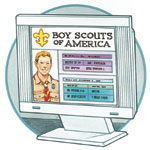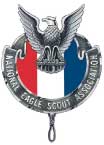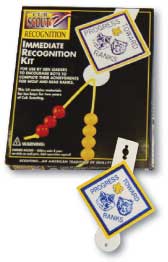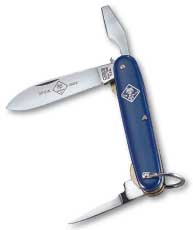
News Briefs
OA plans national service projects this summer
This summer, the Order of the Arrow (OA), in cooperation with the U.S. Forest Service, will conduct five national service projects in a program dubbed ArrowCorps5. Five thousand physically fit OA members (both youth and adult) are being recruited to set an example of service leadership for those who value our national forests.
![]() The National Order of the Arrow Committee and key sponsors will fund these projects. Participants will pay a $250 fee to help pay for accommodations, meals, and a full day of recreational activities during the projects.
The National Order of the Arrow Committee and key sponsors will fund these projects. Participants will pay a $250 fee to help pay for accommodations, meals, and a full day of recreational activities during the projects.
Dates and locations are:
- Mark Twain National Forest, Mo., June 7-14.
- Manti-La Sal National Forest, Utah, June 14-21.
- George Washington and Jefferson National Forests, Va., June 21-28.
- Shasta-Trinity National Forest, Calif., July 12-19.
- Bridger-Teton National Forest, Wyo., July 26-August 2.
For more information, go to http://event.oa-bsa.org.
Apply for National Eagle Scout Association scholarships
 Eagle Scouts who are graduating high school seniors and will attend an accredited college or university that awards at least a bachelor's degree may qualify for a scholarship awarded by the National Eagle Scout Association (NESA).
Eagle Scouts who are graduating high school seniors and will attend an accredited college or university that awards at least a bachelor's degree may qualify for a scholarship awarded by the National Eagle Scout Association (NESA).
Candidates must have received the Eagle Scout Award before applying, demonstrated leadership ability in Scouting and strong participation in activities outside Scouting, and achieved an SAT and/or ACT score acceptable by the standards set by the review committee. All applicants must provide one signed recommendation letter from a volunteer or professional Scout leader who knows them personally.
Available scholarships include:
- Mabel and Lawrence S. Cooke Scholarships (Form 58-702C)—one $48,000 scholarship (up to $12,000 per year) and four $20,000 scholarships ($5,000 a year for four years). Applicants must demonstrate academic aptitude as well as financial need.
- National Eagle Scout Scholarship Fund (Form 58-702C)—Scholarships provided vary each year, depending on the funds available.
- Hall/McElwain Merit Scholarships (Form 58-714B)—Based on merit, these are open to high school seniors and undergraduate students through their junior year in college. The number of scholarships available varies annually depending on funds available.
Applications will be available on the NESA Web site at www.nesa.org; at local Scout council service centers; or from NESA, 1325 W. Walnut Hill Ln., P.O. Box 152079, Irving, TX 75015-2079.
Scholarship applications must be postmarked no later than midnight on Jan. 31, 2008.
Manufacturer Recalls Cub Scout Immediate Recognition Kit
The manufacturer of the BSA‘s Cub Scout Immediate Recognition Kit (BSA No. 01804) has issued a voluntary recall of the product.
 The recall is due to paint lead levels on the kit‘s totem badge in excess of U.S. Consumer Product Safety
Commission standards.
The recall is due to paint lead levels on the kit‘s totem badge in excess of U.S. Consumer Product Safety
Commission standards.
Kahoot Products, Inc., of Roswell, Ga., urges persons to return their Immediate Recognition Kits
to a Scout shop or other BSA Supply distributor. Consumers can visit www.kahoot.com or call (888) 800-4717 for the most up-to-date information about the recall.
All inventory of the tainted product has been removed from shelves of Scouts shops and other retailers that sell the product.
Persons will receive a new Immediate Recognition Kit when they return their old one to any Scout shop or BSA distributor.
The new kit has a different BSA Supply number, 17018. Additionally, the new badge can be distinguished by an inscribed diamond-shape cut on the back side of the badge.
To encourage Cub Scouts and Scouters to exchange old Immediate Recognition Kits for new ones, Kahoot will sponsor a contest drawing for three lucky Cub Scouts to win a Mongoose BMX
Bike.
SCOUTING SAFELY RESOURCES NOW ONLINE
The BSA has a new online resource regarding questions of health, safety, and risk management. The information can be found on the BSA’s Web site, www.scouting.org.
By clicking on the “Scouting Safely” tab along the left-hand side of the home page, volunteers can access risk management, health, safety, and training information. The Guide to Safe Scouting, as well as health and safety alerts and other health- and safety-related publications, will be available. A frequently asked questions (FAQ) section will be updated periodically with new information.
Online training for troop committee members
Members of a troop committee can now take training online by completing the Troop Committee Challenge at the BSA Learning Center (http://olc.scouting.org).
The fun and interactive training is a vital tool for both new and veteran troop committee members. It is designed to help the troop committee work as a team to improve the Scouting experience for adult and youth members while also helping to build the commitment of individual committee members.
The Troop Committee Challenge will take about an hour to complete and can be taken individually or with a small group. Upon finishing the training, a Scouter can print out a certificate of completion.
The BSA Learning Center includes a variety of online training opportunities, such as Cub Scout Leader, Boy Scout Leader, and Venturing Advisor Fast Start; Youth Protection Training; Safety Afloat; Safe Swim Defense; and Venturing Crew Orientation.”
New positions added to Venturing leadership
 Three new positions have been added to crew leadership opportunities in Venturing, the BSA program for young men and women age 14 through 20.
Three new positions have been added to crew leadership opportunities in Venturing, the BSA program for young men and women age 14 through 20.
- The crew quartermaster is responsible for keeping an inventory of and maintaining crew supplies and equipment in good working order, monitoring the return of equipment lent to crew members, and generating a list of the crew’s future equipment and supply needs.
- The Venture crew guide serves as an individual mentor for new Venturers, assisting in their understanding of the program and participation in crew activities.
- The crew historian collects and preserves memorabilia, press releases, photos, and other data of historical significance to the crew, and maintains information about crew activities and members.
“It is fitting, as Venturing approaches its 10th birthday [in February 2008], that crews think about their future, preserving crew history [historian] and maintaining supplies [quartermaster] for upcoming members. Also, as membership in crews increases, the role of a guide, assisting with the transition into membership, is vital,” said Amy DiFrancesco, a former national Venturing president.
Share extra copies of Scouting magazine
If your household receives more than one copy of Scouting magazine and you don’t need the additional copy, we suggest donating it to one of the following: a neighbor, friend, or co-worker; a school, church, or Scout unit library; a barbershop, hospital, or doctor’s or dentist’s office; or your workplace reception area.
BSA partners with national Lewis and Clark trail organization
The Lewis and Clark Trail Heritage Foundation and the BSA have formed a partnership aimed at meeting the growing needs of the 3,700-mile Lewis and Clark National Historic Trail, which extends from Illinois to the Pacific Ocean and runs through 11 states.
The agreement promotes programs of awareness, education, and stewardship between local BSA councils and the foundation’s 40 chapters throughout the country.
“Eagle Scouts and Venturing crews in particular are ideal for conducting larger, in-depth trail projects with our chapters,” said Wendy Raney, foundation director of field operations.
Since 1969, the foundation, headquartered in Great Falls, Mont., has been dedicated to preserving both the story of the 1804-1806 Lewis and Clark Expedition and the route it traveled.
The BSA partnership idea grew out of cooperative efforts between the foundation’s Lone Star Chapter, based in The Woodlands, Tex., and local Cub Scouts, Raney said. In March 2007, chapter members used the Cub Scout handbook to develop appropriate activities for the Cub Scouts and help them earn BSA activity badges and belt loops.
“The very fundamentals of Scouting were captured in the Indian lore activities, as well as the actual story of the Lewis and Clark adventures in the wilderness,” said Cubmaster Barry Carroll of The Woodlands.
“Our event connected the dots between Scouting, adventure, and the American dream,” added Robert McDavitt, a Pack 772 den leader. “I learned as much as my son did, and the adults were moved by all that Scouting has in common with the Lewis and Clark Expedition.”
Find out more about the foundation, the BSA partnership, and trail stewardship opportunities at www.lewisandclark.org.
-- Bill Sloan
Troops can earn the National Camping Award
Boys join Scouting to go camping and have fun with their friends, and boys stay in troops that go camping. BSA research has proven that troops that camp monthly are larger and retain more boys than troops that don’t camp monthly.
The BSA’s National Camping Award recognizes troops that deliver a year-round camping program to their members. It is available for two levels: annual camping and cumulative camping.
- The annual National Camping Award, a green ribbon for troop flags, is available in four categories: 10 days and nights—Unit Award; 20 days and nights—Bronze Award; 30 days and nights—Silver Award; 50 days and nights—Gold Award.
The year for earning the annual award may be a calendar year, charter year, or any 12-month period that best serves the troop’s program goals, as determined by the troop’s patrol leaders’ council.
Summer camp, district camporees, and weekend camp-outs are all included in a troop’s total days and nights camped in a year. As explained in the application form, at least 50 percent of members must attend summer camp and at least 33 percent must attend weekend camp-outs, to count toward the award.
- The cumulative National Camping Award (a white ribbon for troop flags) has four categories for all camping done since Jan. 1, 1999: 100 days and nights—Unit Award; 250 days and nights—Bronze Award; 500 days and nights—Silver Award; 1,000 days and nights—Gold Award.
- In troops that earn the National Camping Award, individual National Camping Award patches are available for Scouts and leaders. Camp-outs with patrols, families, or other groups can be counted when qualifying for the individual award.
The award application, “Our Camping Log” (BSA No. 33690A), includes requirements, suggestions for planning an effective outdoor program, a chart for tracking individual troop member camping records, and a form (which must be signed by the district camping chairman or unit commissioner, Scoutmaster, and senior patrol leader) for submitting to the council camping committee when an award level has been reached.
Subscribe to scouting magazine
All BSA registered adult volunteers receive Scouting magazine as part of their $10 annual registration fee.
Now, for only $9.95, nonregistered individuals can purchase a one-year subscription to Scouting (six issues) on the magazine’s Web site at: http://shop.scoutingmagazine.org/subscribe/.
Issues of the magazine are January-February, March-April, May-June, September, October, and November-December.
A Cub Scout’s First Knife
In the council Scout shop, a lot of people ask for advice on buying a first knife for their Cub Scout. In fact, so many people inquire that I want to share the following insight into BSA knives.
 There are two main points to consider when choosing the right knife for your Cub Scout: (1) boys of Cub Scout age have smaller hands, and (2) they are not familiar with using sharp instruments like knives.
There are two main points to consider when choosing the right knife for your Cub Scout: (1) boys of Cub Scout age have smaller hands, and (2) they are not familiar with using sharp instruments like knives.
Since these boys are just beginning to use a knife, you don't want one that includes a lot of extra gadgets and goodies. These can distract a Cub Scout from the fact that he has a potentially dangerous item in his hand.
I always recommend that parents keep it simple and cost-effective.
The Cub Scout Utility Knife (BSA No. 01883, $19.99) is a perfect example of a good first Cub Scout knife.
It has one blade, an awl, a standard screwdriver, can opener, and cap lifter—all the basic tools a Cub Scout needs for leatherworking or woodcarving, but no extras.
All tools are stainless steel, and the sides are high-impact-resistant plastic. The knife also includes a lanyard ring for attaching it to almost anything.
I've had people come in and ask for the “dullest” knife we sell because they don’t want their boy to cut himself.
In reality, a dull knife is an unsafe knife. The more pressure you have to put on the blade to cut something, the more apt you are to slip and cut yourself. And make no mistake; a dull blade will cut you just as easily as a sharp one.
Besides, why would we sell a dull knife?
Finally, one of the least-known facts about the knives sold in our Scout shop is that they all come with the Supply Group policy of a 100 percent customer-satisfaction guarantee.
-- By Brian T. Buchanan, Senior Clerk, Gerald R. Ford Council Scout Shop
Editor’s note: A version of this item originally appeared in the Gerald R. Ford Council newsletter, The Backpack.
Need forms? Get them here
A wide variety of important and often required forms for pack, troop, team, and crew activities and programs are conveniently available as downloads from the BSA national Web site at www.scouting.org/forms.
While forms are available at local Scout council service centers and in some BSA publications, the online source offers a convenient way for Scouters to obtain copies at any time.
Included are key forms such as the Unit Money-Earning Application (No. 34427B), Medical Exam Class 1 and 2 (No. 34424B) and Class 3 (No. 4412B); Application for Alternate Eagle Scout Rank Merit Badges (No. 58-730); and an Accident and Sickness Claim Form.
Also available are helpful items such as an Informed Consent Agreement (Permission Slip, No. 34-38), Troop Resource Survey (No. 34437), and Campfire Program Planner (No. 33696A).
In addition, the site has numerous forms for use in planning unit meetings and activities; tracking individual advancement; earning special achievements, such as the 50-Miler Award Application (No. 34408A); and recording progress toward various leader recognition awards.
Many Boy Scout council Web sites include a link to www.scouting.org/forms or to key individual forms found on the site.
The Language of Scouting is available online
Need help with the correct spelling and capitalization of Scouting terms? You find the answer to just about every question in The Language of Scouting, available on the BSA national Web site at www.scouting.org/identity/los.
The guide includes information about the terms and style associated specifically with Scouting and grammar, spelling, and style norms used by the Custom Communication Division at the BSA national office.
For example, you’ll learn that the uppercase is correct style for Scoutmaster and Cubmaster but not for den leader or patrol leader.
A see’n’do (one-day activity providing public exposure for Boy Scouting) is different from a showando (an event for leaders blending leadership skills with outdoor and camping skills).
There’s a Klondike derby and a pinewood derby, an Eagle service project and an Eagle Scout Recognition Dinner, a Scout Law and a Scout motto and Scout slogan, a Living Circle (Cub Scout ceremony) and a Scout benediction.
Other examples: Sea Scout leaders take advanced training to earn a Seabadge, while Scouters earn a Wood Badge by completing the Wood Badge for the 21st Century course.
The site also includes definitions of National Council and local council professional (and some paraprofessional) positions, abbreviations and acronyms used in Scouting, and abbreviations (both standard and postal) for states in the United States.
Council ombudsman is problem solver deluxe
The dictionary defines “ombudsman” as someone who investigates complaints, mediates disputes, and/or solves problems. In Indiana’s Crossroads of America Council, the job belongs to 30-year BSA volunteer Joanne Burfeind.
“Joanne is the kind of volunteer you never want to turn loose of,” said council Scout Executive Scott Clabaugh. “There’s no written job description for what she does, but she helps us out in three major areas.
“She serves as a quality control officer for our units and their leaders; she supports our professional staff by dealing with human resource problems and concerns; and she helps us implement new initiatives for both staff and volunteers. She can do it all!”
Like many other volunteers, Burfeind first became involved in Scouting when her son was a Cub Scout in the mid-1970’s. In the decades since, her tirelessness and versatility have led her into a host of jobs that constitute full-time (albeit unpaid) employment. One of those jobs is writing a regular column for the council newsletter, focusing on such topics as training, unit activities, and community service.
“She got drafted to do the column because she’s such a good writer—much better than I am,” Scout Executive Clabaugh explained. “She spends a lot of time on training issues, and she puts in as many hours as any of our paid staff.”
In Clabaugh’s view, every Boy Scout council could benefit from a council ombudsman of this caliber. “Unfortunately, though,” he quickly added, “not every Scout council has a Joanne Burfeind.”
Requirements for Scout ranks and merit badges
Before starting on a merit badge, a Scout should check the current requirements in the latest version of Boy Scout Requirements (No. 33215).
Updated annually, the booklet is available for purchase at local Scout council service centers, Scout shops, and online at www.scoutstuff.org. It lists current requirements for all merit badges, rank advancements, and Eagle Palms, and is a key resource for Scouts, leaders, and troop libraries. The requirements book is important because merit badge pamphlets are continually being updated.
For example, the requirements for Archaeology, Art, Athletics, Aviation, Climbing, Graphic Arts, Journalism, Personal Fitness, and Rowing include changes that were effective Jan. 1, 2007. And the latest editions of pamphlets for 29 other merit badges reflect changes that were effective Jan. 1, 2006.
In Scout troops, the troop librarian should annually review the merit badge pamphlet library to remove and replace outdated editions.
Scouts who began work on a merit badge before requirement changes were introduced can continue using either all the old or all the new requirements but may not mix them.
Merit Badge Counselors
Individuals who wish to serve as merit badge counselors should submit the BSA Merit Badge Counselor Information form (No. 34405) and an adult leadership application (No. 28-501) to the local council service center. (Both forms can be downloaded at www.scouting.org/forms.)
Merit badge counselors must be at least 18 years old, proficient in the merit badge subject by vocation or avocation, able to work with Scout-age boys, and registered with BSA.
Counselors must agree to follow the requirements of the merit badge, making no deletions or additions, ensuring that the advancement standards are fair and uniform for all Scouts; have a Scout and his buddy present at all instructional sessions; and renew their registration annually to continue as a merit badge counselor.
January - February 2008 Table of Contents
Copyright © 2008 by the Boy Scouts of America. All rights thereunder reserved; anything appearing in Scouting magazine or on its Web site may not be reprinted either wholly or in part without written permission. Because of freedom given authors, opinions may not reflect official concurrence.